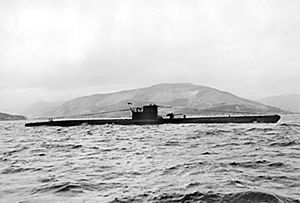German submarine U-776 facts for kids
class="infobox " style="float: right; clear: right; width: 315px; border-spacing: 2px; text-align: left; font-size: 90%;"
| colspan="2" style="text-align: center; font-size: 90%; line-height: 1.5em;" | 
|} The German submarine U-776was a special type of submarine called a Type VIIC U-boat. It was part of Nazi Germany's navy, the Kriegsmarine, during World War II. This submarine was ordered in November 1940. Its construction started on March 4, 1943, at the Kriegsmarinewerft shipyard in Wilhelmshaven. It was launched into the water on March 4, 1944. The U-776officially joined the navy on April 13, 1944, under the command of Lothar Martin.
Contents
| History | |
|---|---|
| Name | U-776 |
| Ordered | 21 November 1940 |
| Builder | Kriegsmarinewerft, Wilhelmshaven |
| Yard number | 159 |
| Laid down | 4 March 1943 |
| Launched | 4 March 1944 |
| Commissioned | 13 April 1944 |
| Fate |
|
| General characteristics | |
| Class and type | Type VIIC submarine |
| Displacement |
|
| Length |
|
| Beam |
|
| Height | 9.60 m (31 ft 6 in) |
| Draught | 4.74 m (15 ft 7 in) |
| Installed power |
|
| Propulsion |
|
| Speed |
|
| Range | |
| Test depth |
|
| Complement | 4 officers, 44–52 enlisted |
| Armament |
|
| Service record | |
| Part of: |
|
| Commanders: |
|
| Operations: |
|
| Victories: | None |
Submarine Design and Features
German Type VIIC submarines were a common type of U-boat used during the war. The U-776 was designed to be powerful and effective.
Size and Weight
When U-776 was on the surface, it weighed about 769 tonnes (which is like 769,000 kilograms!). When it was underwater, it weighed even more, about 871 tonnes. The submarine was quite long, measuring about 67.10 meters (220 feet) from end to end. Its main body, called the pressure hull, was 50.50 meters (165 feet 8 inches) long.
The submarine was 6.20 meters (20 feet 4 inches) wide and 9.60 meters (31 feet 6 inches) tall. It sat 4.74 meters (15 feet 7 inches) deep in the water.
Engines and Speed
U-776 had two powerful diesel engines for moving on the surface. These engines could produce a lot of power, between 2,800 and 3,200 horsepower. When submerged, it used two electric motors that produced 750 horsepower.
The submarine had two propellers to push it through the water. It could travel at a top speed of 17.7 knots (about 32.8 kilometers per hour) on the surface. Underwater, it was slower, reaching a maximum speed of 7.6 knots (about 14.1 kilometers per hour).
Range and Depth
When surfaced, U-776 could travel a very long distance, about 8,500 nautical miles (15,700 kilometers) at a speed of 10 knots. This means it could cross oceans! Underwater, its range was much shorter, about 80 nautical miles (150 kilometers) at 4 knots.
The submarine was built to go deep underwater. It could safely operate at depths of up to 220 meters (720 feet). Its maximum crush depth, where the pressure would be too much, was between 250 and 295 meters (820 and 968 feet).
Crew and Weapons
The U-776 needed a crew of about 44 to 52 people, including 4 officers.
For defense and attack, the submarine was equipped with several weapons:
- Five torpedo tubes (four at the front and one at the back). It could carry 14 torpedoes or 26 mines.
- One 8.8 cm (3.5 inch) deck gun with 220 rounds of ammunition.
- One 3.7 cm (1.5 inch) Flak M42 anti-aircraft gun.
- Two twin 2 cm (0.79 inch) C/30 anti-aircraft guns.
Service History
The U-776 took part in only one war patrol during its time in service. During this patrol, it did not sink or damage any enemy ships.
Surrender and Fate
On May 16, 1945, the U-776 surrendered to the Allied forces at Portland, UK. For a short time, the British Navy used it for tests and even gave it a new name, N-65. It was also toured along the British coast.
Later, the submarine was moved to Loch Ryan, Scotland. After the war ended, many German U-boats that had surrendered were sunk in an operation called Operation Deadlight. U-776 was one of 116 U-boats chosen for this operation.
On December 3, 1945, U-776 was being towed out to the area where it was supposed to be sunk. However, it started to sink on its way there. It was one of 56 U-boats that sank before reaching the planned scuttling areas.
A newspaper article from May 23, 1945, mentioned the U-776:
The U-776, one of the German submarines which were surrendered at Weymouth is now moored to Westminster Pier, close by the Houses of Parliament, and will open to public inspection tomorrow. Our pictures show the submarine on her arrival at Westminster and a view of the engine room. — Wednesday 23 May 1945 - London, "Surrendered U-BOAT at Westminster Pier", The Times
The remains of the U-776 now lie at these coordinates: 55°08′N 05°30′W / 55.133°N 5.500°W.

